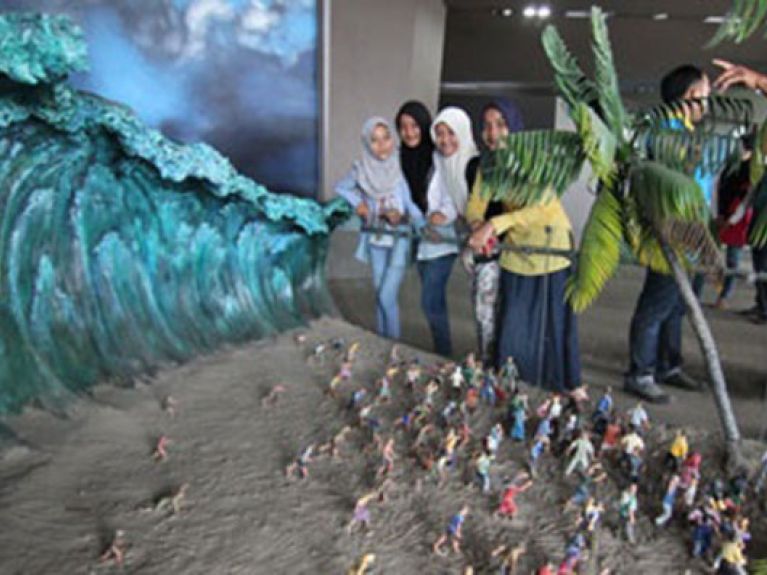German engagement in the aftermath of the tsunami disaster
Ten years ago, a severe seaquake triggered a devastating tsunami in the Indian Ocean. Germany provided assistance on a grand style. An interview on the sustainability of that assistance with one of the people responsible.

On 26 December 2004, a huge submarine earthquake triggered devastating tsunamis in the Indian Ocean. Many of the region’s coasts were devastated; more than 230,000 people died, 165,000 in Indonesia alone. The global assistance offered after the disaster – both public and private – was impressive. The German Society for International Cooperation (GIZ) is one of the organizations that became engaged on behalf of Germany’s Federal Government in Sri Lanka, Thailand and Indonesia. Interview with Dr Wolfgang Hannig, overall coordinator of the GIZ-supported reconstruction programmes for Indonesia from 2005 to 2008 (and today the GIZ’s country director in Ethiopia).
Dr Hannig: after the tsunami you were in the then devastated Indonesian province of Aceh and experienced a lot as GIZ reconstruction coordinator. What particularly impressed you personally?
I was deeply moved by the fact that most people in Aceh didn’t despair in the face of the devastation caused by the tsunami. They saw the disaster as a test and as a challenge from God. Their will to help themselves was truly impressive, especially among the women. When I was in the camps in mid-2005, many people still seemed to be paralysed. Yet the women in particular were trying to generate income. For example, they baked cakes or weaved mats. They were the ones who said: “You don’t need to build us any houses; we’ll do that ourselves. Give us the means of production so that we can earn the necessary money.” Our work would not have borne fruit without this attitude on the part of the population. The GIZ alone had around 55 million euros at its disposal for technical cooperation in Aceh. But even if there had been ten times that amount, it wouldn’t have worked without the people’s determination to help themselves.
It’s now ten years after the disaster. Is the reconstruction work yielding successes?
Yes. The German Embassy in Jakarta published a report in September 2014 after embassy employees had travelled around Aceh to answer precisely this question. They came to a positive overall result. There was still a civil war going on in Aceh in 2004. But the tsunami triggered a peace process, since both sides could now put down their arms without losing face, given the terrible situation of the surviving population. As from 2006, this made economic development that benefited the people possible. This in turn was extremely important for maintaining peace. The people noticed that peace was paying off, that there was a peace dividend. The GIZ financed means of production, among other things. For example, a fishing cooperative received a boat to replace one that had been destroyed by the tsunami; a seamstress received a sewing machine. We offered business training to people who had craft skills, but little knowledge of how to run a business. Another priority was vocational training. New vocational schools were built from scratch; others that had not been destroyed were renovated and re-equipped, vocational-school teachers trained and curricula modernized. We also trained a fifth of the former fighters from the separatist GAM to give them career prospects in civilian life. One year after the civil war, for example, I met the GAM’s most famous weaponsmith, who was now melting down old weapons and turning them into ships’ propellers. In total we trained 1,100 ex-combatants for a civilian career. In this way, Germany made an important contribution to peace in Aceh. And the peace is still holding today.
In Indonesia, a modern tsunami early-warning system was also built with German support. Is it working?
The hardware was designed and built by the German Research Centre for Geosciences, Potsdam (GFZ). This system is technically one of most advanced in the world. The scientists have also learned from failures. A buoy-based system that didn’t work well in practice was replaced by a land-based system. It has 300 sensor stations and is simultaneously connected to GPS. It’s accurate and quick. That’s so important for Indonesia, because the earthquake epicentres are on the sea bed near the coast. With the help of a so-called Decision Support System, the responsible authorities in Jakarta can determine within a few minutes whether to issue a tsunami warning. According to the GFZ in Potsdam, the system is very reliable and the Indonesian authorities are well trained in handling it in the meantime. The Indonesians have been operating it without any outside support since March 2014.
Technology is one thing. But are the people of the region as a whole better prepared against tsunamis today?
Yes, definitely. The people now know a lot more about tsunamis and are well trained to handle an emergency. What is known as last-mile management was one of the GIZ’s main jobs. When a tsunami warning is issued in Jakarta, an information chain must be set in motion across the country all the way to the people on the coast. The information must reach the local administration and be spread by megaphones, radio, telephone and other information media like the internet, to make sure that the people reach safe meeting points at a higher altitude. The GIZ produced materials to inform and train the population, and organized regular exercises and safe meeting points. As far as I know, the system is working fine and is also taken very seriously by the Indonesian population.
Has there also been a transfer of knowledge outside of Aceh?
Being a maritime nation with 17,000 islands, Indonesia has of course also passed this know-how on to other regions. The archipelago is located on the so-called Ring of Fire, where there are many volcanoes which trigger earthquakes; it’s also on a tectonic fault line. That means that the islands from Flores to the northern tip of Sumatra are at risk. There has also been a knowledge transfer between the individual countries of the Indian Ocean that could potentially be affected by a tsunami again – like on 26 December 2004.

